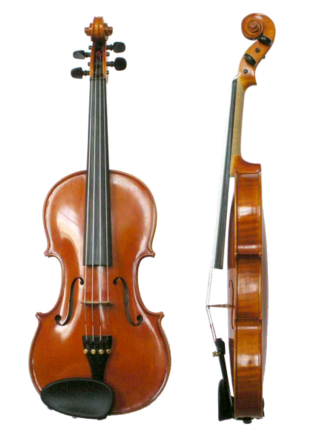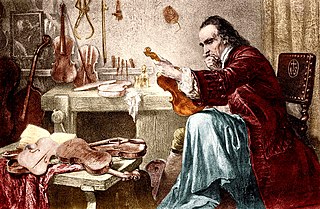
The violin, sometimes referred as a fiddle, is a wooden chordophone, and is the smallest, and thus highest-pitched instrument (soprano) in regular use in the violin family. Smaller violin-type instruments exist, including the violino piccolo and the pochette, but these are virtually unused. Most violins have a hollow wooden body, and commonly have four strings, usually tuned in perfect fifths with notes G3, D4, A4, E5, and are most commonly played by drawing a bow across the strings. The violin can also be played by plucking the strings with the fingers (pizzicato) and, in specialized cases, by striking the strings with the wooden side of the bow.

Authentication is the act of proving an assertion, such as the identity of a computer system user. In contrast with identification, the act of indicating a person or thing's identity, authentication is the process of verifying that identity. It might involve validating personal identity documents, verifying the authenticity of a website with a digital certificate, determining the age of an artifact by carbon dating, or ensuring that a product or document is not counterfeit.

Antonio Stradivari was an Italian luthier and a craftsman of string instruments such as violins, cellos, guitars, violas and harps. The Latinized form of his surname, Stradivarius, as well as the colloquial Strad are terms often used to refer to his instruments. It is estimated that Stradivari produced 1,116 instruments, of which 960 were violins. Around 650 instruments survive, including 450 to 512 violins. His instruments are considered some of the finest ever made, and are extremely valuable collector's items.

A Stradivarius is one of the violins, violas, cellos and other string instruments built by members of the Italian family Stradivari, particularly Antonio Stradivari, during the 17th and 18th centuries. They are considered some of the finest instruments ever made, and are extremely valuable collector's items.
In music, a bow is a tensioned stick which has hair coated in rosin affixed to it. It is moved across some part of a musical instrument to cause vibration, which the instrument emits as sound. The vast majority of bows are used with string instruments, such as the violin, viola, cello, and bass, although some bows are used with musical saws and other bowed idiophones.
The Guarneri, often referred to in the Latinized form Guarnerius, is the family name of a group of distinguished luthiers from Cremona in Italy in the 17th and 18th centuries, whose standing is considered comparable to those of the Amati and Stradivari families.
Real estate appraisal, property valuation or land valuation is the process of assessing the value of real property. Real estate transactions often require appraisals because every property has unique characteristics. The location also plays a key role in valuation. Appraisal reports form the basis for mortgage loans, settling estates and divorces, taxation, and so on. Sometimes an appraisal report is used to establish a sale price for a property.
Predatory lending refers to unethical practices conducted by lending organizations during a loan origination process that are unfair, deceptive, or fraudulent. While there are no internationally agreed legal definitions for predatory lending, a 2006 audit report from the office of inspector general of the US Federal Deposit Insurance Corporation (FDIC) broadly defines predatory lending as "imposing unfair and abusive loan terms on borrowers", though "unfair" and "abusive" were not specifically defined. Though there are laws against some of the specific practices commonly identified as predatory, various federal agencies use the phrase as a catch-all term for many specific illegal activities in the loan industry. Predatory lending should not be confused with predatory mortgage servicing which is mortgage practices described by critics as unfair, deceptive, or fraudulent practices during the loan or mortgage servicing process, post loan origination.

Charles Jean Baptiste Collin-Mezin (1841–1923) was a French maker of violins, violas, cellos, basses and bows. He was an Officier de l'Académie des Beaux-Arts and won gold and silver medals at the Paris Exhibitions in 1878, 1889, and 1900.

Jean-Baptiste Vuillaume was a French luthier, businessman, inventor and winner of many awards. His workshop made over 3,000 instruments.
Nicolò Gagliano, although there is some discussion about the exact dates), was an Italian violin-maker, the eldest son of Alessandro Gagliano. He made many admirable instruments, often imitated. Some have been mistaken for those of Stradivari. Nicolò was a more prolific maker than his brother Gennaro (Januarius). Nicolò and Gennaro are considered the greatest luthiers in the Gagliano family and the pinnacle of Neapolitan violin-making. Although Nicolò's work is not always entirely consistent in quality, it often shows great distinction. His instruments have bold and well-proportioned archings, with the instrument scrolls having a distinctive elongated pegbox and small tight spiral. He often placed a small label with a religious dedication inside his instruments.

The violin, viola and cello were first built in the early 16th century, in Italy. The earliest evidence for their existence is in paintings by Gaudenzio Ferrari from the 1530s, though Ferrari's instruments had only three strings. The Académie musicale, a treatise written in 1556 by Philibert Jambe de Fer, gives a clear description of the violin family much as we know it today.

Bartolomeo Giuseppe "del Gesù" Guarneri was an Italian luthier from the Guarneri family of Cremona. He rivals Antonio Stradivari (1644–1737) with regard to the respect and reverence accorded his instruments, and for many prominent players and collectors his instruments are the most coveted of all. Instruments made by Guarneri are often referred to as Del Gesùs.

Matteo Goffriller (1659–1742) was a Venetian luthier, particularly noted for the quality of his cellos. He was active between 1685–1735 and was the founder of the "Venetian School" of luthiers, during a time when Venice was one of the most important centers of musical activity in the world.

Giovanni Paolo Maggini, was a luthier born in Botticino (Brescia), Italy. Maggini was a pupil of the most important violin maker of the Brescian school, Gasparo da Salò.
Francesco Rugeri, also known as Ruger, Rugier, Rugeri, Ruggeri, Ruggieri, Ruggerius, was the first of an important family of luthiers, the Casa Rugeri in Cremona, Italy. His instruments are masterfully constructed. His violins are inspired by Nicolò Amati's "Grand Amati" pattern. Francesco was the first to develop a smaller cello design, which has become the standard for modern cello dimensions. Today, Rugeri's instruments are nearly as renowned as Nicolò Amati's instruments.

Ernst Heinrich Roth (1877–1948), also often referred to as Ernst Heinrich Roth I to distinguish him from later family members of the same name, was a German luthier and master of a large and successful violin-making workshop in the East German town of Markneukirchen, near the current border with the Czech Republic. He was the most important and distinguished figure in a whole dynasty of Roth luthiers active in Germany over many generations and to this day.
Nicolas François Vuillaume (1802–1876) was an important French luthier of the Vuillaume family, and younger brother of the illustrious Jean-Baptiste Vuillaume. He ran the leading workshop in Brussels, Belgium, and was appointed instrument maker to the Royal Conservatory in Brussels. His instruments won a number of medals at exhibitions.
Vincenzo Rugeri, was an Italian luthier of string instruments such as violins, cellos, and, violas in Cremona, Italy. His instruments are noted for their craftsmanship and tone quality. Vincenzo came from a distinguished family of luthiers, the first of whom was his father, Francesco Rugeri. Despite the local tradition of artisan families laboring together through generations, Vincenzo left the family shop and set up a successful shop of his own in the center of Cremona. Vincenzo was the third son of luthier Francesco Rugeri. Vincenzo's work, like Francesco's, is influenced by Nicolò Amati's Grand Pattern model, however Vincenzo's work was distinguished from his father's by utilizing a lower arch inspired by Antonio Stradivari. An analysis of the body of his work reveals that the quality of Vincenzo's instruments is remarkable, perhaps even more so than his father's. Vincenzo's instruments, though less numerous, are valued at least equal to those of his father. A violin by Vincenzo Rugeri realized $502,320 on October 3, 2011 at Brompton's Auctions in London. Carlo Bergonzi was a distinguished apprentice of Vincenzo Rugeri.

The Le Brun Stradivarius of 1712 is a violin made by Italian luthier Antonio Stradivari of Cremona (1644–1737). It is the only violin from Stradivari’s golden period known to have been owned and played by the violinist Niccolò Paganini. When sold at a Sotheby's auction in London in November 2001 it achieved one of the highest prices ever paid for a violin at auction, and became the most expensive instrument in Europe.







